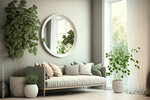


Even in New England, the trend towards blurring the line between indoor and outdoor living has become increasingly popular. It doesn’t seem to stop.
Why is this happening? One reason might be because of the rise of sustainable and eco-friendly architecture; the importance of connecting people with nature has become more apparent. This has led to a surge in indoor-outdoor design trends, which aim to seamlessly integrate interior spaces with the surrounding environment.
With the region's rich history and natural beauty, it's no surprise that local homeowners are looking to connect with nature. Sometimes that means bringing the outside in. And sometimes, it’s about eliminating the barriers between the inside and the outdoors.
One of the most notable trends in indoor-outdoor design is simply about using natural materials. Incorporating materials such as wood, stone, and natural fibers into interior spaces creates a warm and welcoming ambiance while also connecting the indoors with the outdoors.
Susan Muzio Blake has helmed Muzio Designs, a retail store located in a rustic barn on John Wise Avenue for nearly a dozen years. She said indoor-outdoor design, especially in New England, where most of the calendar year brings unpredictable weather, should begin indoors.
“In New England, we are eager to have our indoor space become a natural extension of the outdoors,” she said. “Incorporating lighter finishes on furniture and wall coverings, sustaining live plants, and table lighting are just a few elements of design that are currently trending.”
Additionally, using large windows or sliding glass doors can allow for natural light to flood into the space and provide unobstructed views of the surrounding landscape.
Michael Gray, managing director at Carpenter & MacNeille architecture and design firm in Essex, said one architectural element we like to use is folding glass doors or windows to completely opens a wall or area to the outside. The use of continuous stone flooring which flows from the interior to the exterior (with no step) enhances this effect.
“The challenge in New England is to create a seamless flow from inside to outside in good weather while directing water/snow away from the door in winter and maintaining a tight seal when closed,” he said. “Large roof overhangs and slightly pitched flooring with in-floor drainage and gaskets help address this.” Another trend, according to Gray? Creating an outdoor walk-up bar to a kitchen counter by using a smaller version of the folding door—used as a window above the kitchen counter— which allows immediate access to the kitchen wall and provides a counter to the outside.
“It’s a fun, useful approach to extend your indoor living to the outside in warm weather while maximizing light and views in the winter,” he said.
Then, of course, there’s the use of plants and greenery. Many forget that incorporating plants into interior spaces can help to purify the air and create a calming atmosphere. Additionally, using plants that are native to Cape Ann can help to further connect the interior with the exterior. It creates a beautiful aesthetic and helps blend your interior with the outdoors and the surrounding environment.
Finally, there’s the all-important attention to designing your outdoor space to maximize everyday living and entertaining when the season is in full bloom.
Many are opting to create outdoor living spaces that are as comfortable and luxurious as their indoor counterparts. This trend has led to the rise of outdoor kitchens, fire pits, and comfortable seating areas. These outdoor spaces provide homeowners with an additional area to entertain guests, relax, and enjoy the natural beauty of their surroundings.
The use of lighting design and technology has also influenced indoor-outdoor design trends. Smart home systems can be used to control everything from lighting to sound, making it easy for homeowners to seamlessly transition between indoor and outdoor spaces. Additionally, advances in lighting technology have made it possible to create a variety of moods and atmospheres, both inside and outside the home. Just remember, outdoor lighting should be subtle to avoid light pollution and the unappealing airport “landing strip” comparison.
Ultra-low-voltage lights placed along paths and at the base of architectural trees can transform an otherwise ordinary backyard area.
In the end, the trend towards indoor-outdoor design is only getting bigger. As more people become aware of the importance of connecting with nature, we can expect to see continued growth in this area of design.
Whether it's through the use of natural materials, plants, or technology, the goal is always the same: to seamlessly integrate interior spaces with the surrounding environment, creating a more harmonious and enjoyable living experience that reflects the region's unique charm.